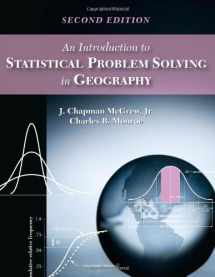
An Introduction to Statistical Problem Solving in Geography
Book details
Summary
Description
Written for undergraduate geography majors and entry-level graduate students with limited backgrounds in statistical analysis and methods, McGrew and Monroe provide a comprehensive and understandable introduction to statistical methods in a problem-solving framework. Engaging examples and problems are drawn from a variety of topical areas in both human and physical geography and are fully integrated into the text. Without compromising statistical rigor or oversimplifying, the authors stress the importance of written narratives that explain each statistical technique. After introducing basic statistical concepts and terminology, the authors focus on nonspatial and spatial descriptive statistics. They transition to inferential problem solving, including probability, sampling, and estimation, before delving deeper into inferential statistics for geographic problem solving. The final chapters examine the related techniques of correlation and regression. A list of major goals and objectives is included at the end of each chapter, allowing students to monitor their own progress and mastery of geographic statistical materials. An epilogue, offering over 150 geographic situations, gives students a chance to figure out which statistical technique should be used for a particular situation.


We would LOVE it if you could help us and other readers by reviewing the book
Book review



